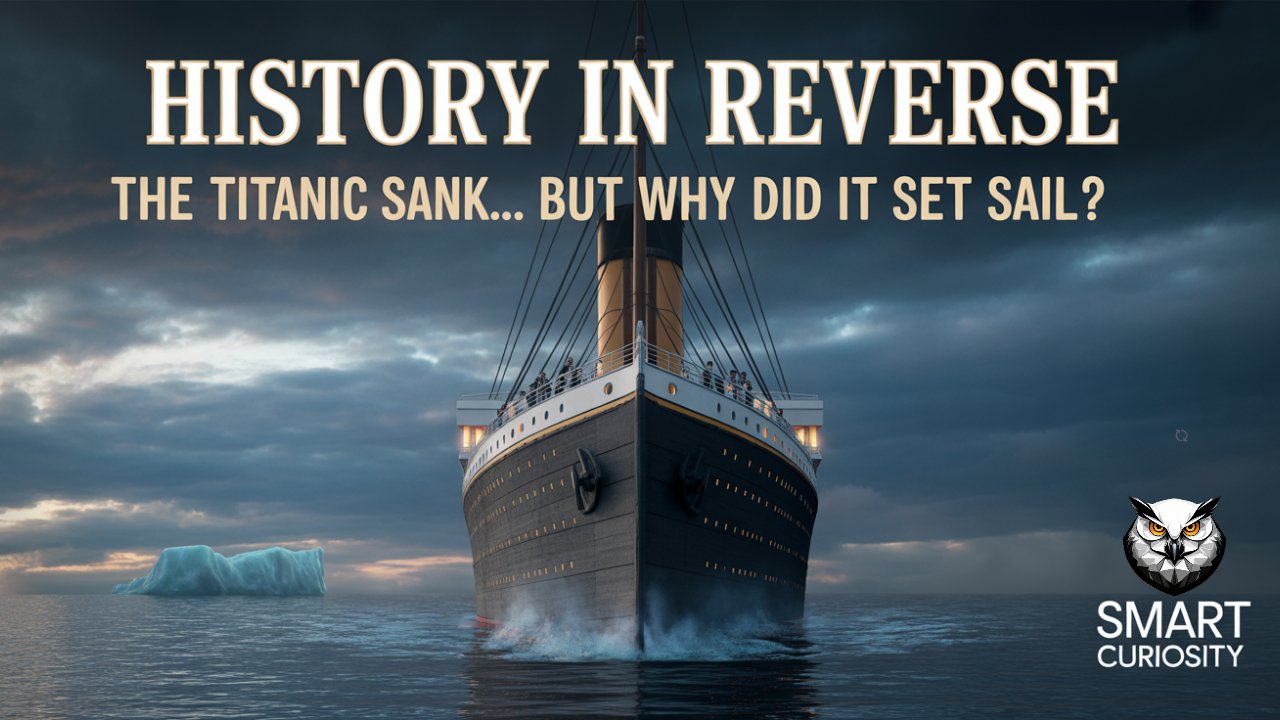For over a century, one image has been frozen in our collective minds: the R.M.S. Titanic, a colossus of the sea they called “practically unsinkable,” mortally wounded by an iceberg in the dead of night. We’ve been told it was a tragic accident… a cruel twist of fate in the icy North Atlantic. We’ve mourned the 1,500 souls lost, studied the wreck, and watched the story retold time and again. We all know how it ended.
But what if the story we know is incomplete? What if the sinking of the Titanic wasn’t just an accident, but an inevitability? The real tragedy might not be that it hit an iceberg. The real mystery is why it ever left the dock in the first place, steaming into a sea of known dangers, driven by a fatal combination of greed, ambition, and pride. To understand why the Titanic sank, we first have to ask why it sailed. The answer is far more shocking than a simple shipwreck. It’s the story of a ship that was, in many ways, in trouble before it ever touched the water.
To get why there was so much pressure to launch the Titanic on April 10th, 1912, we have to look at the world that built it. The early 20th century was an age of explosive industrial growth. Empires were built on the sea, and the North Atlantic was the most lucrative, most competitive shipping lane on the planet a battlefield, not of cannons, but of propellers and funnels.
At the heart of this battle were two British titans: the venerable Cunard Line and the ambitious White Star Line. Cunard had just unleashed its new ocean greyhounds: the Lusitania and the Mauretania. They were marvels of speed, capturing the public’s imagination and the coveted “Blue Riband” for the fastest transatlantic crossing. It was a direct challenge to White Star’s dominance.
White Star Line, controlled by the American financial titan J.P. Morgan, needed a knockout response. The vision, championed by White Star’s chairman, Bruce Ismay, was audacious. If they couldn’t be the fastest, they would be the biggest and the most magnificent. They wouldn’t build a greyhound; they’d build a floating palace. Or rather, three of them.
This was the birth of the Olympic-class liners: the Olympic, the Titanic, and the Britannic. These ships were designed to be the definitive statement of maritime power. The Titanic would be the largest moving object on Earth, its scale almost incomprehensible. It was a symbol of raw power, a testament to what British engineering and American money could do.
But it wasn’t just about size; it was about pure luxury. The Titanic was a floating extension of the Gilded Age. For its fabulously wealthy First-Class passengers, it offered amenities that rivaled the finest hotels. The grand staircase, topped with a magnificent glass dome, was a masterpiece. There were Parisian-style cafes, a Turkish bath, a squash court, and even a heated swimming pool almost unheard of at the time. This was a world built for the likes of John Jacob Astor and Benjamin Guggenheim. The Titanic wasn’t just a ship; it was a status symbol.
But the ship’s business model relied on more than the ultra-rich. Deep below the polished decks, in the cramped quarters of Third Class, was the other part of the economic engine. Hundreds of emigrants from Britain, Ireland, and Scandinavia were packed into these lower decks, chasing a new life in America. They were the human cargo that helped make these grand voyages profitable. The Titanic was a perfect microcosm of Edwardian society: a glittering crust of extreme wealth built on a vast foundation of working-class hope.
The ship was also a source of immense national and civic pride. Built in Belfast at the Harland and Wolff shipyards, the Titanic was the pride of Northern Ireland. Its construction employed thousands. The day it launched into the River Lagan, over 100,000 people came to watch. This wasn’t just a ship; it was a symbol of British might, a declaration that Britannia still ruled the waves. This colossal weight of expectation from financiers, executives, shipbuilders, and the public created an atmosphere where delay was simply not an option.
Long before an iceberg scarred its hull, the Titanic may have already been wounded. It carried a dangerous secret, known to a handful of crew but hidden from the public. Deep inside the ship, in a three-story-tall space known as Coal Bunker #6, a fire was burning.
This wasn’t a flicker. It was a spontaneous combustion fire within the mountain of coal, a known and surprisingly common hazard on steamships. The fire likely began during sea trials, almost ten days before the ship left Southampton. Crew members fought it around the clock, shoveling the burning coal directly into the furnaces to control the blaze by simply burning through it.
But the fire was stubborn. It was still burning as the ship was loaded and as first-class passengers admired their suites. The White Star Line faced a critical choice. Acknowledging the fire meant a potential delay, emptying the massive bunker, and, worst of all, terrible press. The “unsinkable” ship, sidelined by a fire before its first voyage? It was unthinkable.
So, a fateful choice was made: conceal it and handle it at sea. Some accounts even suggest the still-smoldering side of the hull was deliberately turned away from the dock in Southampton to hide any visual evidence from the public.
A controversial theory, brought to mainstream attention by journalist Senan Molony, argues this fire was a critical factor in the disaster. He points to photographs that he claims show a 30-foot dark streak on the hull right where the iceberg would later strike, arguing it’s evidence of heat damage. Metallurgists supporting this theory explain that a coal fire could reach temperatures that weaken steel, making the hull and the crucial watertight bulkhead behind it brittle.
However, this theory is heavily debated and is not accepted by the majority of Titanic historians. Many experts point out that bunker fires were common and manageable, and that the damage from the iceberg was so extensive and spread across six compartments that the ship was doomed regardless. Recent forensic analysis and digital scans of the wreck confirm the iceberg created catastrophic damage along the hull, but do not support the fire being a decisive factor.
Still, the fire may have had another fatal consequence. Some researchers have speculated that the need to empty the bunker was the real reason the Titanic was traveling at a high speed of around 22 knots through a known ice field. This, too, is a minority view, as most evidence suggests the speed was standard practice for the time to maintain a schedule. But whether to burn fuel or save time, the pressure to push forward, full steam ahead, created a powerful incentive to ignore the warnings that lay in their path.
The smoldering fire was a troubling secret, but as the great ship prepared to sail, a series of other careless decisions began to pile up a perfect storm of logistical pressure and human error.
First, a national coal strike had paralyzed British shipping. For White Star, the timing was a catastrophe. Postponing the most anticipated voyage of the decade was not an option. So, they began cannibalizing resources, canceling the trips of other ships and transferring their coal, provisions, and even passengers to the Titanic. This move solved the fuel crisis but concentrated all the company’s hopes and liabilities onto a single vessel. The ship had to sail.
As the Titanic pulled away from Southampton on April 10th, it gave a terrifying preview of its own power. The water displaced by its massive hull created a suction that ripped the nearby liner, the SS New York, from its moorings. A collision was narrowly avoided by just a few feet. For many, it was a terrifying omen, a reminder that the ship’s unprecedented size also made it dangerously unwieldy.
After stops in France and Ireland, the Titanic steamed into the open Atlantic. It was now a self-contained world, a steel island moving at high speed. And here, the most critical warnings began to arrive crackling through the headphones of the wireless operators. The Marconi wireless was revolutionary, but on the Titanic, its primary function was commercial. For a fee, wealthy passengers could send personal messages ashore. This was a lucrative business for the Marconi Company, which employed the operators, Jack Phillips and Harold Bride. Ice warnings were secondary.
On Sunday, April 14th, the day of the collision, at least six critical messages detailing heavy ice directly in the Titanic’s path were received from ships like the Caronia, the Baltic, and the Amerika. The Mesaba sent a detailed report covering the exact area the Titanic was about to enter. That message, arguably the most important, never made it to the bridge. Overwhelmed by a backlog of passenger telegrams after an equipment failure, senior operator Jack Phillips reportedly set the ice warning aside as non-urgent.
The final, most direct warning came around 10:55 PM from the SS Californian, a ship so close it had stopped for the night, completely surrounded by ice. Its operator, Cyril Evans, messaged the Titanic: “I say, old man, we are stopped and surrounded by ice.” A frustrated Phillips, trying to transmit passenger messages, allegedly cut him off with a sharp reply: “Shut up! Shut up! I am busy.” Following protocol, Evans then switched off his set and went to bed. The final voice that could have saved the Titanic fell silent.
This catastrophic failure in communication was partly technological and partly due to a pervasive culture of complacency. Captain Edward Smith did make a slight course adjustment after earlier warnings, but he never ordered a significant reduction in speed. Steaming at 22 knots on a moonless, unnaturally calm night into a known ice field was a calculated risk a risk based on the belief that any danger could be spotted in time to be avoided.
This belief was shattered by one final, absurd failure. The binoculars for the crow’s nest were locked in a cabinet, and the key was in the pocket of an officer who had been transferred off the ship in Southampton. In his haste, he forgot to hand over the key. This forced the lookouts, Frederick Fleet and Reginald Lee, to rely on the naked eye to pierce the darkness of a night with no moon and an ocean as flat and black as glass. Fleet later testified that with binoculars, he believed they could have seen the iceberg “enough to get out of the way.” While some experts argue that given the conditions, binoculars might not have made a difference, for the men in the nest that night, it was a critical missing tool.
The stage was set. A ship with a hidden fire, pushed to sea by economic pressure, steaming too fast, guided by a command that dismissed direct warnings, and blinded by a missing key. The iceberg wasn’t an accident. It was an appointment.
Ultimately, the Titanic didn’t sink because of a single failure. It sank because of choices made by men, each guided by their own pressures and fatal blind spots. The disaster was a tragedy of human character.
At the top was Captain Edward John Smith, the celebrated “Millionaire’s Captain.” With over 40 years at sea, this maiden voyage was meant to be his crowning achievement before retirement. But his vast experience may have bred a deadly complacency. He knew about the ice warnings, but he subscribed to the standard practice of the time: you don’t slow down for ice, you post lookouts and steer around it. This had worked for decades. Smith wasn’t reckless by the standards of his day, but he was a 19th-century captain confronting a 20th-century disaster, failing to grasp that the rules for smaller ships didn’t apply to the behemoth under his command.
On his shoulder, perhaps literally and figuratively, was the most powerful man on board: J. Bruce Ismay, chairman of the White Star Line. Ismay’s presence became one of the most controversial parts of the saga. Survivors and the press, fueled by Ismay’s rival William Randolph Hearst, painted him as the villain who relentlessly pressured Captain Smith to maintain a reckless speed for a record-breaking arrival in New York. Ismay denied these accusations, and there is no definitive evidence of a direct order. But his ambition and very presence likely created an implicit pressure on Captain Smith to make a good showing. Ismay’s survival, stepping into one of the last lifeboats, would forever brand him a coward in the court of public opinion, though the official British inquiry largely exonerated him.
The third key figure was Thomas Andrews, the ship’s chief designer from Harland and Wolff. Unlike Smith and Ismay, Andrews represents not hubris, but tragic knowledge. He knew the ship’s famous watertight compartments weren’t capped at the top. He knew that if more than four of the sixteen compartments were breached, water would spill over the bulkheads in a fatal domino effect.
When Captain Smith showed him the damage report, it was Andrews who delivered the death sentence. He quietly informed the captain that the iceberg had opened six compartments to the sea. The ship was doomed. He calculated it would sink in under two hours. As chaos erupted, Andrews became a quiet hero, calmly directing passengers to the lifeboats, fully aware there weren’t enough for everyone. He was last seen in the first-class smoking room, his architectural masterpiece sinking beneath his feet.
It was this combination of characters that proved so lethal: Smith’s traditionalism, Ismay’s commercial ambition, and Andrews’s devastating knowledge. The decision to sail, to push on at speed, and to downplay warnings wasn’t the fault of one man, but the result of a system that believed technology and prestige outweighed precaution.
In the end, the story of the Titanic is not about an unsinkable ship, but an unthinkable mindset. A mindset that allowed a company to potentially hide a dangerous fire to protect its schedule. A mindset that drove a captain to maintain high speeds in the face of repeated, explicit warnings. A mindset that prioritized passenger telegrams over navigational safety.
It wasn’t just an iceberg that sank the Titanic. It was the crushing weight of financial expectation, the blinding glare of national pride, and the fatal flaw of human hubris. The disaster was not a single event that occurred at 11:40 PM on April 14th, 1912. It was the inevitable conclusion of a thousand prior decisions.
The legacy of the Titanic is written in the reforms that followed: the creation of the International Ice Patrol, 24-hour radio watches on all ships, and the mandate that every vessel must carry enough lifeboats for every person on board. These laws were written in the ink of tragedy. The story endures not just because of the drama of its sinking, but because it’s a timeless, humbling cautionary tale. It reminds us that no matter how grand our ambitions, we are never immune to the consequences of our own arrogance. The real reason the Titanic set sail is the same reason its story will be told forever: as a chilling testament to the cost of a dream that refused to wake up to the dangers right in front of its eyes.
The story of the Titanic is filled with countless mysteries. What part of this story shocked you the most? Do you think the pressure for speed was the biggest factor, or was it the failure to heed the warnings? Let us know your theories in the comments below. And if you enjoy diving into the hidden histories behind the world’s greatest events, make sure to subscribe and hit the notification bell so you don’t miss our next investigation.





